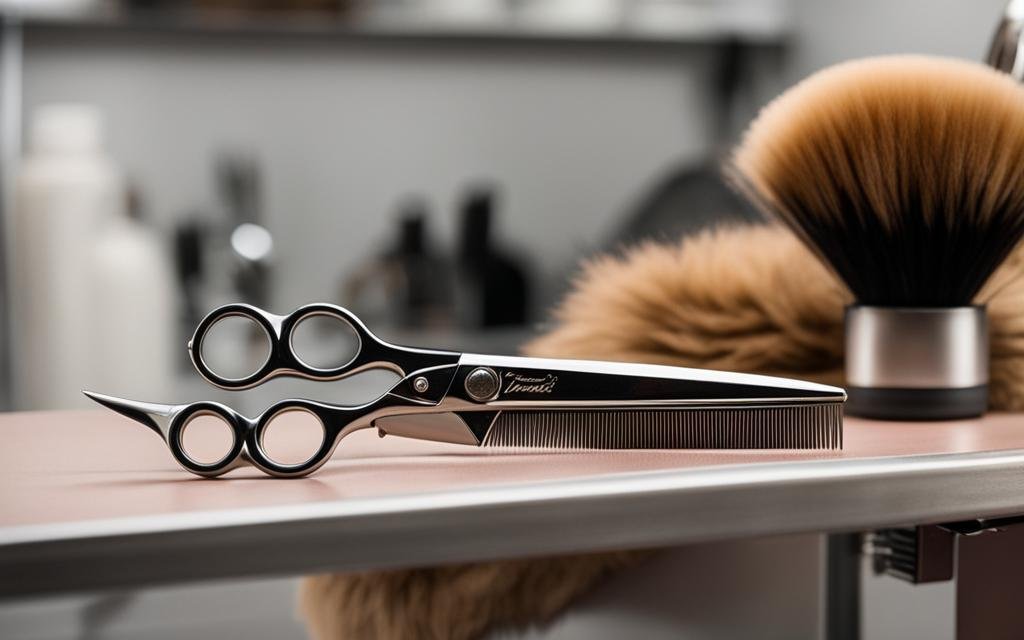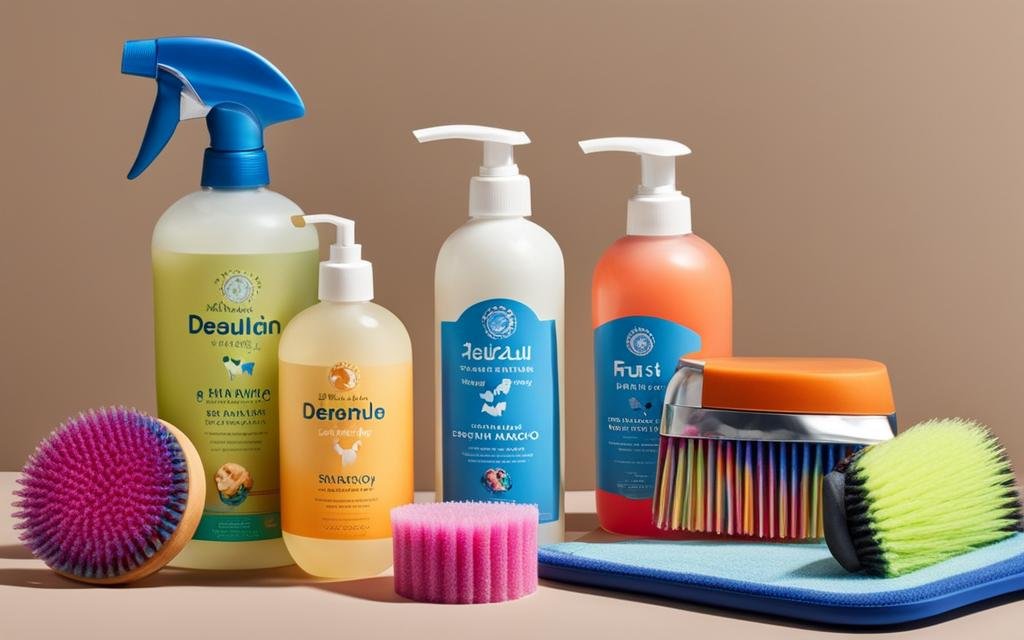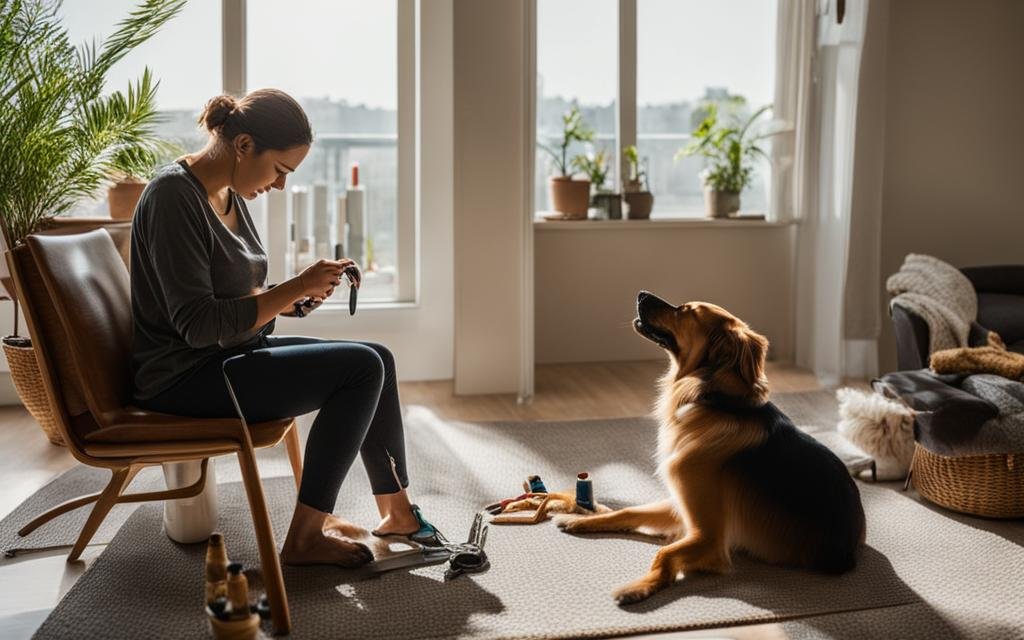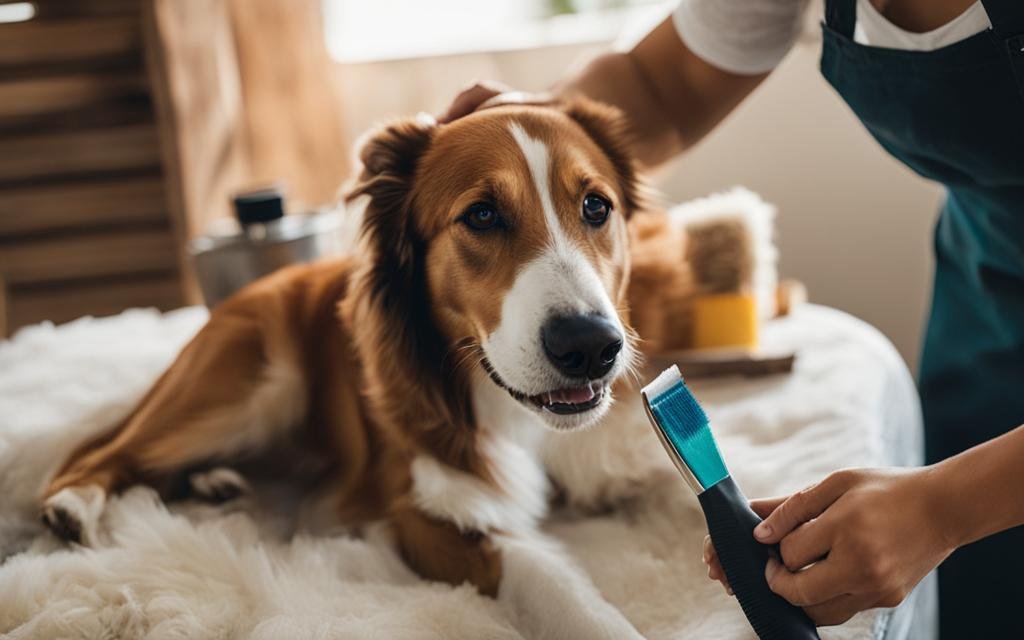Grooming your pet is an essential part of ensuring their health and happiness. Not only does it keep their coat clean and tangle-free, but it also allows for regular check-ups on their overall well-being. While many pet owners choose to rely on professional groomers, there’s something truly special about taking on the role yourself. DIY grooming not only allows you to develop a deeper bond with your pet but also gives you the opportunity to showcase your love and expertise in pet grooming.
By learning and mastering grooming techniques, you can provide your furry friend with the care they deserve. Whether it’s brushing, bathing, or trimming their nails, DIY grooming allows you to be hands-on in maintaining their hygiene, appearance, and comfort.
In this article, we will explore the value of home grooming and the benefits it brings to both you and your pet. We will delve into essential DIY pet grooming tools and their uses, as well as provide guidance on mastering grooming techniques for different breeds. Additionally, we will cover bathing tips and products, brushing and combing fundamentals, nail trimming at home, the importance of oral hygiene, managing grooming anxiety, and comprehensive care from paw to tail.
So, get ready to embark on a grooming adventure that will not only strengthen your bond with your pet but also showcase your expertise in pet grooming. Let’s dive in!
Key Takeaways:
- DIY grooming allows pet owners to develop a deeper bond with their pets.
- By learning and mastering grooming techniques, pet owners can ensure the well-being and happiness of their pets.
- Regular grooming sessions at home allow pet owners to spot health issues early.
- DIY grooming provides an opportunity for pet owners to build strong bonds with their pets through gentle touch and care.
- Pet owners must choose between professional grooming and DIY methods based on factors such as their pet’s temperament, specific grooming needs, and financial considerations.
The Value of Home Grooming: Balancing Professional Services and DIY Techniques
Regular grooming sessions at home provide pet owners with numerous benefits, allowing them to maintain their pet’s well-being and strengthen the bond between them. While professional groomers offer valuable services, home grooming offers unique advantages that should not be overlooked. In this section, we will explore the value of home grooming by highlighting how it helps pet owners spot health issues early, build strong bonds with their pets, and make informed decisions between professional grooming and DIY methods.
Spotting Health Issues Through Regular Grooming
Grooming sessions at home provide an opportunity for pet owners to closely observe their pets and detect any changes in their body or health conditions. By regularly grooming their pets, owners can spot potential health issues such as skin irritations, lumps, or abnormal growths. This early detection allows for prompt veterinary attention and can significantly improve the outcome of any potential health concerns. Additionally, home grooming enables a deeper understanding of the pet’s normal appearance, facilitating the identification of any subtle changes that may indicate underlying health problems.
Building Strong Bonds with Your Pet via Grooming
Grooming sessions present a wonderful opportunity for pet owners to build a strong bond with their furry companions. The gentle touch and care provided during grooming sessions help strengthen the emotional connection between the owner and the pet. Regular grooming enables a positive and intimate interaction that promotes trust and affection. It allows pet owners to spend quality time with their pets, providing them with love and care while enhancing the overall well-being of both the owner and the pet.
Choosing Between Professional Groomers and DIY Methods
When deciding between professional grooming services and DIY methods, pet owners must consider several factors. The temperament of the pet, the specific grooming needs, and financial considerations all play a role in making the right choice. While professional groomers offer expertise and convenience, DIY grooming provides a personal touch and a unique opportunity for pet owners to actively contribute to their pet’s well-being. By developing grooming skills and knowledge, pet owners can ensure that their pets receive proper care and attention in the comfort of their own homes.
Essential DIY Pet Grooming Tools and Their Uses

To successfully groom pets at home, it is important to have the right tools. Essential DIY pet grooming tools include:
- Brushes: Brushes help remove dirt, loose hair, and tangles, and improve blood circulation in the pet’s skin.
- Combs: Combs are useful for removing debris, untangling knots, and ensuring a smooth and well-groomed coat.
- Nail clippers: Nail clippers are necessary for trimming a pet’s nails to the appropriate length and preventing them from becoming too long or sharp.
- Grooming scissors: Grooming scissors are designed for precise trimming of fur, particularly around the face, paws, and tail areas.
- Pet-specific shampoos and conditioners: Using shampoos and conditioners specifically formulated for pets ensures their coat remains clean, healthy, and free of irritants.
Each of these tools serves a specific purpose in the grooming process, promoting the well-being and appearance of your pet. With the right tools at hand, you can provide your furry friend with professional-level grooming from the comfort of your own home.
Mastering DIY Pet Grooming Techniques for Various Breeds
Understanding Breed-Specific Grooming Needs
Different breeds have specific grooming needs that pet owners should be aware of. These needs can vary based on coat length, texture, and maintenance requirements. For example, long-haired breeds, such as the Persian cat or the Shih Tzu dog, may require more frequent brushing and coat maintenance to prevent matting and tangles. On the other hand, breeds with short hair, like the Labrador Retriever or the Dalmatian, may require less grooming attention but still benefit from regular brushing to remove shedding hair and keep their coats healthy.
By understanding the specific grooming needs of your pet’s breed, you can tailor your grooming techniques accordingly. Researching breed-specific grooming requirements and seeking advice from professional groomers or breed-specific associations can provide valuable insights and guidance.
Adapting Your Approach to Your Pet’s Unique Coat
Aside from breed-specific grooming needs, each pet has a unique coat that requires a personalized approach. Factors such as coat color, thickness, and sensitivity play a role in determining the grooming techniques that are most suitable for your pet.
It’s important to consider the following when grooming your pet’s unique coat:
- Coat Length: Long-haired coats may require more frequent brushing and detangling to prevent matting, while short-haired coats may benefit from less frequent brushing but still require regular attention to maintain a healthy-looking coat.
- Coat Texture: Some coats might be curly, wiry, or silky, requiring specific grooming tools or techniques. Understanding your pet’s coat texture will help you choose the right brushes, combs, or grooming scissors to achieve the best results.
- Coat Sensitivity: Pets with sensitive skin or allergies may require gentler grooming techniques and hypoallergenic grooming products to avoid irritation or discomfort. Consulting with a veterinarian can provide guidance on suitable grooming products for your pet’s specific needs.
By adapting your grooming approach to your pet’s unique coat, you can prevent common coat-related issues and keep your furry friend looking and feeling their best.
How to Bathe Your Pet Like a Pro: Tips and Products
Bathing your pet is an essential part of their grooming routine. It not only keeps them clean and fresh-smelling but also helps maintain their overall health and well-being. To ensure a successful bathing experience for both you and your furry friend, follow these expert tips and explore some recommended pet bathing products.
1. Select the right pet-specific shampoos and conditioners:
Using pet-specific shampoos and conditioners is crucial for maintaining your pet’s skin and coat health. These products are specifically formulated to cater to the unique needs of different pets, such as dogs, cats, or small mammals. Look for shampoos and conditioners that are gentle, hypoallergenic, and free from harsh chemicals that could irritate your pet’s skin.
2. Maintain proper water temperature:
Ensuring the water temperature is comfortable for your pet is essential. Use lukewarm water to avoid scalding or chilling your furry friend. Test the water on the inside of your wrist, similar to how you would for a baby, to make sure it’s not too hot or cold.
3. Rinse thoroughly:
Proper rinsing is crucial to remove all traces of shampoo and conditioner from your pet’s coat. Leaving any residue can lead to skin irritation and discomfort. Take your time to thoroughly rinse your pet, making sure no product is left behind.
Recommended Pet Bathing Products:

| Product | Description |
|---|---|
| 1. Furbo Dog Camera | A smart monitoring device that allows you to keep an eye on your pet during bath time, even when you’re not at home. |
| 2. Burt’s Bees for Pets | A line of natural pet grooming products that include shampoos, conditioners, and sprays, made with gentle ingredients. |
| 3. Earthbath All Natural Pet Shampoo | A range of natural and biodegradable pet shampoos and conditioners formulated for different coat types, with options for sensitive skin and allergies. |
| 4. The Honest Kitchen Sparkle Dental Gel | A dental gel for pets that helps maintain oral hygiene and freshens breath, promoting overall dental health. |
By following these pet bathing tips and using recommended products, you can ensure that every bathing session becomes a pleasurable experience for both you and your furry friend.
DIY Pet Grooming Techniques: Brushing and Combing Fundamentals
Brushing and combing are essential aspects of pet grooming that contribute to maintaining a healthy and beautiful coat for your furry friend. By regularly brushing and combing your pet’s fur, you can prevent matting, tangling, and promote the distribution of natural oils, resulting in a glossy and well-groomed appearance.
The Right Way to Brush for Healthy Fur
When brushing your pet, it’s important to follow the correct technique to achieve the best results. Start by using a brush suitable for your pet’s coat type, such as a slicker brush for long-haired breeds or a bristle brush for short-haired breeds.
Begin at the head and gently brush in the direction of hair growth, working your way down to the tail. Make sure to brush all areas of the body, including the chest, stomach, and legs, while being attentive to your pet’s comfort.
Pay close attention to any tangles or matted fur you encounter during the brushing process. If you encounter a tangle or mat, use a detangling spray or conditioner specifically formulated for pets to make the process easier.
Incorporate positive reinforcement and treats during the brushing session to make it a positive and enjoyable experience for your pet. This will help build trust and create a bond between you and your furry companion.
Detangling: Preventing Knots and Matting
Preventing knots and matting is crucial in maintaining a healthy and manageable coat for your pet. Regular brushing and combing play a significant role in detangling and preventing the formation of knots.
To detangle your pet’s fur, start by using a wide-toothed comb to gently work through any knots or tangles. Begin at the ends of the hair strands and gradually work your way up towards the roots, ensuring you’re being gentle to avoid causing discomfort to your pet.
If the tangle or mat is too stubborn to comb through, consider using a dematting tool or seeking professional assistance. It’s important to avoid pulling or yanking on the fur, as this can cause pain and discomfort for your pet.
Regular brushing and combing sessions, combined with proper detangling techniques, will help prevent matting and keep your pet’s coat looking and feeling its best.
Navigating the Challenges of Nail Trimming at Home
Trimming a pet’s nails can be a daunting task, especially for pet owners who are new to DIY grooming. However, with some patience, the right techniques, and the proper tools, nail trimming can be successfully done at home, ensuring the comfort and health of your furry friend.
One of the key aspects of successful nail trimming is using the right nail clippers. It is essential to choose clippers that are specifically designed for pets, as they come in different sizes and styles to accommodate various breeds and nail types. This will ensure a safe and effective trimming process.
Before you start trimming your pet’s nails, it is important to understand the anatomy of the nails. The quick is a sensitive area containing blood vessels and nerves, and cutting into it can cause pain and bleeding. By familiarizing yourself with the anatomy, you can trim the nails safely without causing discomfort to your pet.

During the nail trimming process, some pet owners may encounter challenges such as resistance, fear, or difficulty in handling their pet. To address these challenges, it is recommended to introduce nail trimming gradually to your pet. Start by getting them used to having their paws touched and gradually progress to using the nail clippers. Offer treats and positive reinforcement to create a positive association with the grooming experience.
Additionally, it can be helpful to have another person present to help hold and comfort your pet during nail trimming. This can reduce anxiety and make the process smoother for both you and your pet.
To ensure an effective nail trimming session, it is crucial to take breaks when needed. If your pet becomes stressed or agitated, it’s best to pause and resume later to avoid any accidents or injuries.
By following these tips and techniques, you can navigate the challenges of nail trimming at home and provide your pet with regular nail maintenance. Remember, practice makes perfect, and with time, you will become more confident and skilled in trimming your pet’s nails.
Importance of Oral Hygiene in Grooming Routines
When it comes to pet grooming, oral hygiene is often overlooked but is crucial for your pet’s overall health. Just like humans, pets can develop dental problems such as plaque buildup, tartar, and gum disease. Ignoring oral hygiene can lead to discomfort, pain, and even serious health issues for your furry friend. Therefore, it’s important to integrate dental care into your regular grooming routine.
Choosing the Right Dental Tools for Your Pet
Choosing the right dental tools is essential for maintaining your pet’s oral hygiene. Look for toothbrushes specifically designed for pets, as their bristles and size are suitable for their oral structure. Additionally, pet toothpaste is formulated to be safe for ingestion, as pets cannot rinse and spit like humans. Avoid using human toothbrushes or toothpaste, as they can be harmful to your pet.
Toothbrushes come in different shapes, sizes, and designs. Some toothbrushes are designed to fit over your finger for easier access to your pet’s teeth and gums. Others have longer handles for better reach. Consider your pet’s size and temperament when selecting a toothbrush. If your pet is resistant to brushing, you can also try finger brushes or dental wipes as alternatives.
When it comes to toothpaste, choose flavors that are appealing to your pet, such as poultry or beef. This will make the brushing experience more enjoyable and encourage cooperation. As for dental chews or toys, they can serve as supplementary tools for maintaining oral hygiene, but they should not be relied upon as the sole method of dental care.
Regularly inspect your pet’s teeth and gums for signs of oral health problems, such as bad breath, red or swollen gums, tartar buildup, or loose teeth. If you notice any issues or you’re unsure about the right dental tools to use, consult your veterinarian for guidance.
Integrating Dental Care into Your Regular Grooming Schedule
Incorporating dental care into your pet’s regular grooming routine is essential for maintaining their oral health. Brushing your pet’s teeth at least three times a week is recommended by veterinarians. Start slowly and gently introduce the toothbrush and toothpaste to your pet, gradually increasing the duration and frequency of brushing sessions.
Make sure to brush all the surfaces of your pet’s teeth, including the front, back, and chewing surfaces. Angle the toothbrush towards the gumline to ensure effective cleaning. Be patient and provide positive reinforcement, such as treats or praise, to reward your pet for their cooperation.
In addition to brushing, there are other ways to promote good oral hygiene. Regularly providing dental chews or toys can help reduce plaque buildup and promote healthy gums. You can also explore water additives or oral rinses that are specifically formulated for pets.
Remember, prevention is key when it comes to your pet’s oral health. By incorporating dental care into your regular grooming routine, you can help prevent dental problems and ensure your pet’s overall well-being.
Managing Anxiety: Calming Techniques for Stress-Free Grooming
For some pets, grooming sessions can be a source of anxiety and stress. Understanding how to manage and alleviate this anxiety is crucial in promoting a stress-free grooming experience. By implementing calming techniques, pet owners can create a calm and relaxing atmosphere for their pets during grooming sessions.
One effective technique is positive reinforcement, which involves rewarding pets with praise, treats, or toys for their calm behavior during grooming. This helps create positive associations with the grooming process and reduces anxiety over time.
Desensitization is another strategy that can gradually acclimate pets to grooming activities. By introducing grooming tools and procedures slowly and in a non-threatening manner, pets can become more comfortable and less anxious about the process. It’s important to start with short sessions and gradually increase the duration as pets become more at ease.
Calming treats or supplements can also be beneficial in reducing anxiety during grooming. These specially formulated treats or supplements contain natural ingredients that promote relaxation and help pets remain calm during grooming sessions.
To provide a visual illustration of techniques, here’s an image showcasing a pet who is receiving gentle grooming care:
Implementing these calming techniques can significantly reduce grooming anxiety and make the grooming experience more enjoyable for both pets and their owners. By creating a stress-free environment and using positive reinforcement, desensitization, and calming aids, pet owners can ensure that their pets have a pleasant grooming experience.
Paw to Tail Grooming: Comprehensive Care Beyond the Brush
In addition to regular brushing and grooming, comprehensive pet grooming involves taking care of specific areas to ensure the overall well-being and comfort of your furry companion. This section will focus on two important aspects of grooming: ear cleaning and paw health.
Ear Cleaning: Preventing Infection with Routine Care
Cleaning your pet’s ears is an essential part of their grooming routine. Routine ear cleaning helps prevent infections, maintain ear health, and detect any potential issues early on. To clean your pet’s ears:
- Gently hold your pet’s ear flap and lift it upward to expose the ear canal.
- Moisten a cotton ball with an ear cleaning solution specifically formulated for pets.
- Gently wipe the inner folds of the ear, avoiding the ear canal.
- Repeat the process with a fresh cotton ball on the other ear.
It’s important to note that each pet is different, so consult your veterinarian for specific instructions and to ensure the use of appropriate ear cleaning products.
Paw Health: Trimming and Maintenance for Comfort
Paw health is crucial for your pet’s comfort and mobility. Regular paw trimming and maintenance can prevent issues such as overgrown nails, matting between the paw pads, and debris accumulation. Here are some tips for maintaining paw health:
- Trim your pet’s nails regularly, taking care not to cut too close to the quick to avoid bleeding or pain.
- Clean and inspect between the paw pads to remove dirt, debris, or tangled hair.
- Check for any signs of redness, swelling, or injury, and consult your veterinarian if you notice any abnormalities.
- Consider using paw balms or moisturizers to keep the paw pads soft and prevent dryness or cracking.
By incorporating these paw care practices into your pet’s grooming routine, you can help promote their overall comfort and prevent potential paw-related issues.
Remember, comprehensive grooming goes beyond brushing, and paying attention to details such as ear cleaning and paw health is essential for your pet’s overall well-being and happiness.
Conclusion
In conclusion, DIY grooming offers pet owners a wonderful opportunity to develop a deeper bond with their furry companions while ensuring their well-being and happiness. Throughout this article, we have explored the value of home grooming, the essential tools and techniques needed, and the importance of comprehensive care from paw to tail.
By regularly grooming your pet at home, you can not only spot potential health issues early but also build strong bonds through gentle touch and care. While professional groomers offer valuable services, the choice between professional grooming and DIY methods ultimately depends on factors such as your pet’s temperament, specific grooming needs, and financial considerations.
Remember, mastering DIY grooming techniques is within your reach. Armed with the right tools and knowledge, you can provide your pet with professional-level grooming at home. So why not give it a try? With patience, practice, and the tips provided in this article, you can embark on a grooming journey that shows your love and expertise for your pet.
So, start grooming your pet like an expert, and enjoy the benefits of a happier and healthier bond with your beloved companion!
FAQ
What are the benefits of DIY grooming for pets?
DIY grooming allows pet owners to develop a deeper bond with their pets while providing them with the care they need. It also enables pet owners to observe any changes in their pet’s body or health conditions and detect health issues early.
What tools do I need for DIY pet grooming?
Essential DIY pet grooming tools include brushes, combs, nail clippers, grooming scissors, and pet-specific shampoos and conditioners. Each tool serves a specific purpose in the grooming process to maintain a healthy coat, trim nails, and ensure overall cleanliness.
How can I groom my pet’s coat effectively?
To groom your pet’s coat effectively, it is important to understand breed-specific grooming needs and adapt your approach to your pet’s unique coat. Regular brushing and combing help maintain a healthy coat, prevent matting and tangling, and distribute natural oils.
How do I trim my pet’s nails at home?
Trimming a pet’s nails can be done at home with the right techniques and tools. Use proper nail clippers and understand the anatomy of the nails. Taking it slow and providing treats as rewards can help make the process easier.
What is the importance of oral hygiene in pet grooming routines?
Oral hygiene is crucial for a pet’s overall health. It is important to choose the right dental tools, such as toothbrushes and toothpaste, and integrate dental care into your regular grooming schedule to prevent dental issues and maintain good oral health.
How can I manage my pet’s anxiety during grooming sessions?
There are various calming techniques that can be used to create a stress-free grooming experience for pets. Positive reinforcement, desensitization, and the use of calming treats or supplements can help reduce anxiety and make grooming sessions more comfortable for your pet.
What other areas of my pet’s body require grooming?
Comprehensive grooming care for pets includes cleaning their ears to prevent infections and maintaining paw health by regularly trimming their nails and providing overall paw care for comfort and mobility.
Source Links
- https://www.luckypuppygrooming.com/expert-grooming-advice-for-your-pet-pupper/
- https://www.preciouspetcaresd.com/news/ultimate-guide-to-dog-grooming-in-2024/
- https://www.scoutforpets.com/post/diy-pet-grooming-pros-and-cons
